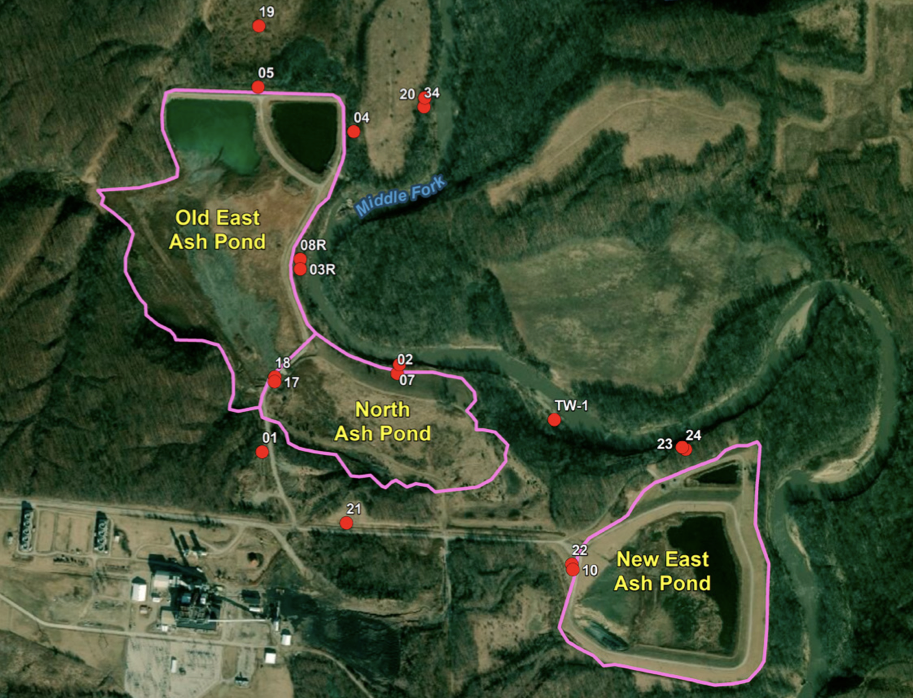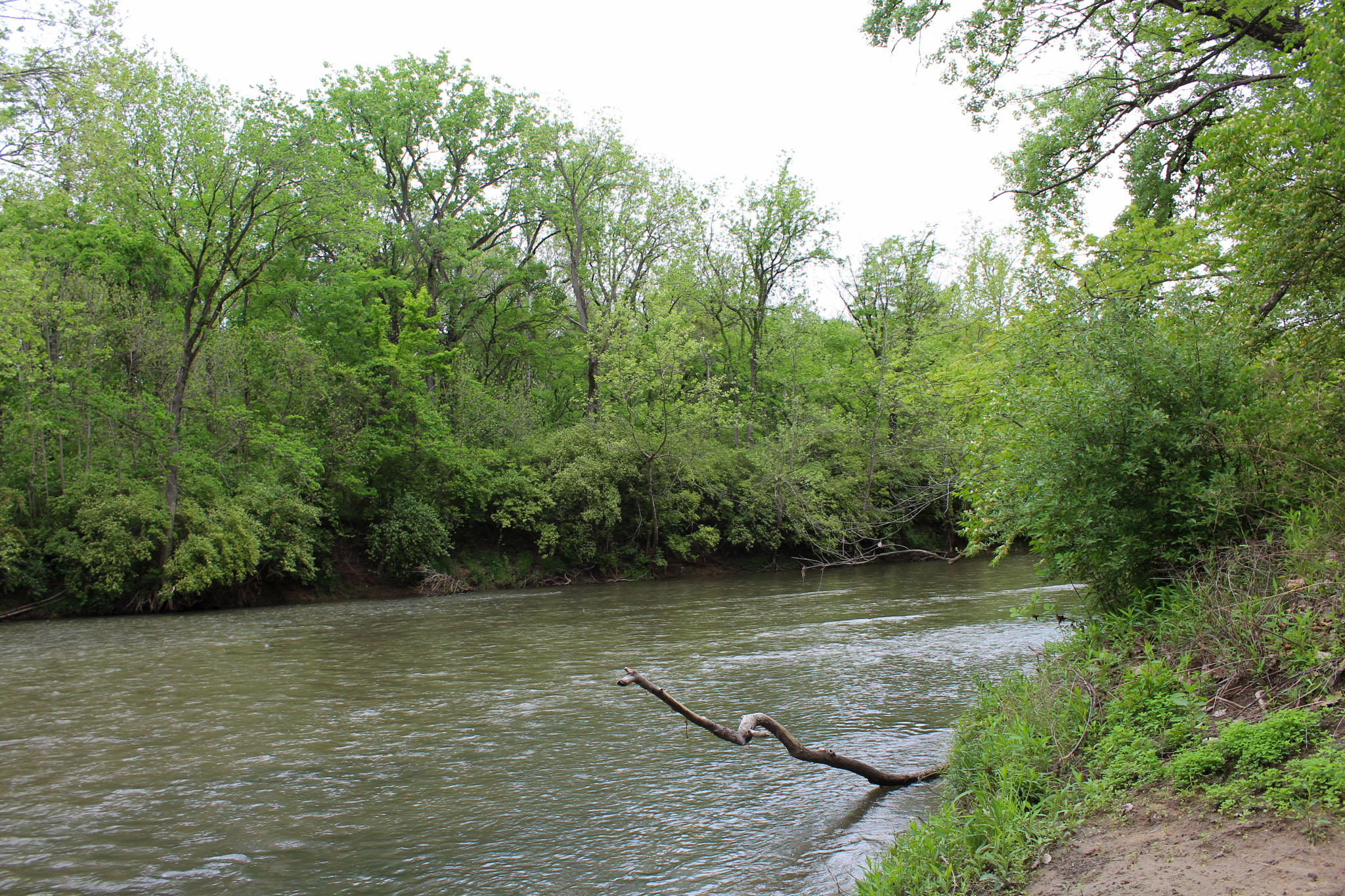DANVILLE — On a recent afternoon in early May, Danville resident Germaine Light leashed up her poodle Pippin to take a walk around Kickapoo State Park, along the Middle Fork of the Vermilion River.
Light lives just a few miles from where a coal-fired power plant operated for over five decades until it closed in 2011. She said she has noticed the facility’s lingering effects on the river.
“I would see trickles of bluish and purplish and greenish streamlets of water coming down the bank,” Light said. “I have a neighbor that fishes a lot, and he says he prefers not to fish the Vermilion because he knows what’s upstream. If he fishes in the Vermilion, he throws it back.”
Coal ash is a byproduct of burning coal. It contains carcinogens and toxins like mercury and lead. Dynegy Midwest Generation took ownership of the site – including its three coal ash ponds — near the Middle Fork in 2018.
Illinois lawmakers have taken steps in recent years to provide more oversight to the dozens of coal ash sites across the state — to ensure toxins don’t leak into the environment.
In 2019, Governor J.B. Pritzker signed the Coal Ash Pollution Prevention Act, which prohibits coal ash discharge into the environment. As a requirement of the act, Illinois adopted rules in 2021 that assigned the Illinois Environmental Protection Agency to assign permits to companies with coal ash ponds, laying out plans to operate on — or close — the sites.
But the process is moving more slowly than some environmental activists would like. At this point, only a couple permits are open for public comment, and none have been issued.
“Whatever the holdup has been, it needs to not be there anymore,” said Jenny Cassel, senior attorney at Earthjustice, a nonprofit public interest law organization. “Everyone has the right to clean water. We’re not taking care of it properly. We need to make sure that not only we’re safe, our children are safe, our grandchildren are safe.”
Concerns about coal ash in Illinois
Dynegy’s coal ash ponds have been leaking into the river and groundwater. Environmentalists fear the three million cubic yards of coal ash will flood into the Middle Fork if the banks erode.

Some local residents and community activists, like Light, worry the coal ash pollution could get worse.
“I’m not as concerned about myself, but I’m more concerned about the entire community,” Light said. “The water needs to be clean. I mean, just think; kids are out there floating down the Middle Fork of the Vermilion River past the Dynegy. Kids, people, that could get sick from being in this.”
Light wishes Dynegy would clean up and remove the coal ash ponds entirely.
“They should be concerned about the community. Any enterprise should be concerned about its effects on the community. If there’s any bad effects, they should be fixed. I mean, who else should have that responsibility?”
Andrew Rehn, climate policy director at Prairie Rivers Network, said one way to prevent groundwater contamination is to relocate the coal ash waste into a pond that’s properly lined to seal it off. But most of the coal ash ponds are not lined this way.
“We basically have a lot of pollution constituents that are leaching into our groundwater, and in some cases, that groundwater is directly connected to surface water,” Rehn said. “The Middle Fork of the Vermilion River is kind of a real spotlight example of coal ash and some of the problems around it.”
Rehn said the amount of coal ash near the Middle Fork amounts to two and a half empire state buildings — typical of many sites across the state.
This worries Tom Monahan, owner of Kickapoo Adventures, which offers a variety of activities, like paddling, tubing and biking along the Vermilion River. He said if the coal ash ponds were to burst into the river, it would shut down his business.
“What was once a beautiful trip, who would want to take it down a contaminated river that’s full of arsenic and other heavy metals and toxins?” Monahan said. “The consequences will be just catastrophic.”
Other states have experienced catastrophic bursts like the kind Monahan fears. In 2008, a coal ash spill in Tennessee led to the release of 5.4 million cubic yards of coal ash into a nearby pond, eventually spilling into the Emory River channel, according to the U.S. EPA.
More oversight is coming, but it’s a slow process
The 2019 Coal Ash Pollution Prevention Act requires the Illinois EPA to approve permits for the operation or removal of all coal ash sites in the state. As part of the process, the agency reviews the permit applications from companies and works with them to address potential concerns and necessary changes.
The permit then opens for a public notice process, where residents can comment and share their concerns. The EPA might choose to revise the permit or not before officially issuing it. Then, inspectors check in regularly with the companies to ensure they’re following the permit’s requirements.
According to Darin LeCrone, manager of the permit section in the Bureau of Water division of Water Pollution Control at the Illinois EPA, the biggest challenge of the process has been the fact that it’s a completely new program.
“It’s not very often that we get a brand new permitting program of this magnitude,” LeCrone said. “There’s lots of new rules for existing programs [so] you’re revising how you do things … Yes, we did regulate these impoundments, but not to this degree.”
He said almost all the permit applications were submitted around the same time, in the fall of 2021. The onslaught of applications led to some delays, he said, and the process of finalizing permits is more complicated than people realize. But LeCrone said he expects things to move more quickly going forward.
Earthjustice Senior Attorney Jenny Cassel is frustrated with how long it’s taking and feels the EPA hasn’t been prioritizing environmental justice communities, which she described as communities susceptible to a disproportionate burden of environmental hazards.
“Those sites needed to be prioritized for closure,” Cassel said. “Most of them submitted their applications on time, and yet here we are two years later, without IEPA prioritizing those sites … that are posing the biggest risks.”
LeCrone with the Illinois EPA said the environmental justice communities have been prioritized, but they tend to need more time to review because their cases are more complicated.
“I understand their concern [about] why those haven’t gone out first, but they have been our priority for the initial review process,” he said. “It just doesn’t mean they’re always then in a position for us to be able to draft the permit first.”

Regardless, Cassel said there needs to be greater effort from all sides to speed up this process.
“We just have to get the coal ash out of the water, and then we can have far safer and cleaner water to drink and swim in,” she said.
New federal regulations, which were issued in late April, aim to reduce pollution from fossil fuel-fired power plants nationwide. These rules increase the number of sites subject to regulation and include some regulations for coal ash.
One of the new rules affects legacy coal ash surface impoundments, which refers to coal ash stored at inactive facilities. They are more likely to be unlined and unmonitored, according to the EPA, which means they’re more prone to leaks than impoundments at active facilities.
“To address these concerns, EPA established safeguards for legacy coal ash surface impoundments that largely mirror those for inactive impoundments at active facilities, including requiring the proper closure of the impoundments and remediating coal ash contamination in groundwater,” the EPA said in a press release.
The original federal coal ash rule, implemented in 2015, didn’t include “historic” disposal units, which contaminate groundwater at currently regulated power plants. These included areas where coal ash, or coal combustion residuals (CCR), was placed directly on the land in impoundments that closed before the 2015 rule was placed and inactive coal ash landfills.
“This final rule extends a subset of EPA’s existing CCR requirements to these historic disposal units that will ensure any contamination from these areas is remediated, and will prevent further contamination,” the press release said.
After alleged contamination, Dynegy says it’s committed to safety
In 2018, the Illinois EPA issued Dynegy a violation notice for contaminating the Middle Fork River under the Environmental Protection Act. Groundwater testing found boron at levels 26 times higher than Illinois’ groundwater standard, manganese 10 times over the standard and sulfate and arsenic above safe levels, according to a report from several environmental justice organizations.
The report states that nearly all coal ash ponds in Illinois were contaminating groundwater at levels above health-based standards. The report used publicly available data from coal-fired power plants, which are required by federal law to publicly report groundwater monitoring data.
In 2023, a settlement was reached between Dynegy and the state, requiring the coal company to clean up its coal ash and resolve its violations.
Dynegy Midwest Generation said in a statement about the settlement that it is committed to closing its coal ash ponds in a way that protects the environment, groundwater resources and public health.
The company said it has begun implementing measures to protect the Middle Fork River in response to the settlement and while the Illinois EPA reviews its permit application. These measures include constructing a groundwater collection trench that prevents contaminated groundwater from leaving the site, implementing a Safety Emergency Response Plan and de-watering the coal ash impoundments, all of which the company said are IEPA-approved.
The company also said it conducts monthly inspections to evaluate the riverbank and determine whether “temporary bank stabilization activities” are needed.
“Given the unique nature of the site and to bring resolution to the matter, the company agreed that if IEPA issues a final closure permit, the company will demolish the former power station and submit for approval to construct an on-site landfill within the footprint of the former plant to store and manage the coal ash,” a Dynegy spokesperson said in a statement.
Dynegy’s coal ash permit is still under review by the Illinois EPA, and the company said the closure process will likely take more than 12 years.

